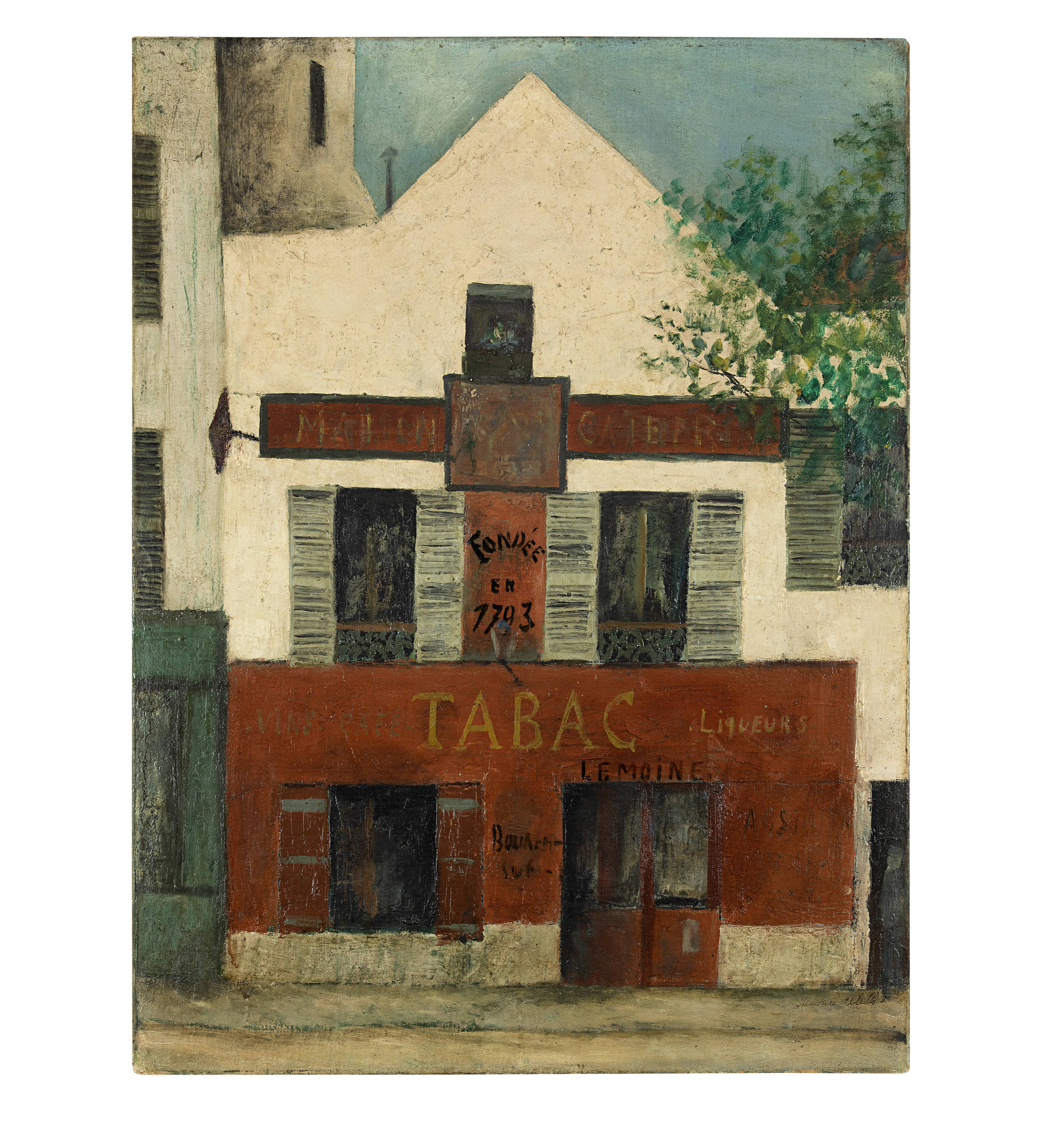- EN
Log in
- Live Auctions
- Past auctions
- More
- Gallery
- Art Dealing
- Publishing
- Kornfeld today
- The Story of Kornfeld
- Information
Note: The image cannot be displayed for legal reasons. For more information, see the PDF of the catalogue: Link to PDF
Paris 1883 - 1955 Dax
Circa 1910-1912
Oil on canvas
81x60.5 cm
Signed lower right by the artist "Maurice. Utrillo. V."
Jean Fabris/Cédric Paillier, Maurice Utrillo, Paris 2009, no. 156
Galerie Barbazanges, Paris
Galerie Flechtheim, Berlin-Düsseldorf (there titled "Tabakladen")
Raeber Gallery, Basel, inv. no. 42317 (there titled "Le bureau de tabac")
Collection Willy Raeber, Basel
Collection Raeber, Basel
Private collection Switzerland
Paul Pétridès, L'oeuvre complet de Maurice Utrillo, vol. 1, Paris 1959, no. 284
Basel 1938, Galerie Raeber, Maurice Utrillo. 20 major works, cat. no. 11
Basel 1942, Kunsthalle, Maurice Utrillo, de Corot à Daumier, cat. no. 219
Winterthur 1955, Kunstmuseum, Europäische Meister. 1790-1910, cat. no. 206
Bern 1963, Museum of Art, Maurice Utrillo, cat. no. 31 or 36
Japan 2005-2006, touring exhibition, cat. no. 11
Paris 2009, Pinacothèque, Valadon-Utrillo, cat. no. 31
Doubled. Minor retouching in the area to the left and right of the upper shield
The artist Suzanne Valadon encouraged her son Maurice Utrillo to paint by having him copy postcards of the winding, narrow streets of Montmartre in Paris. Although his application to the École des Beaux Arts had been rejected in 1909, Utrillo received initial recognition, for example when three of his paintings were included in the Salon d'Automne and the writer and art dealer Louis Libaude acquired some of his works. The period around 1910 to 1912, when Utrillo painted the present work, was a decisive turning point in his career. During this period, Utrillo developed a personal and unmistakable style with his "manière blanche". For the works of this "white period" he used a bleached and ashen colour palette and even mixed plaster into the white oil paint to imitate the weathered facades of buildings. Utrillo did try to work outdoors, but was put off by onlookers and retreated to his studio on Rue Cortot in Montmartre. There he worked from memory and from the postcard views his mother had given him. Photographs were often the basis for his frontal views of buildings and streets, but always freely interpreted.
The motif for the painting offered here was the restaurant "La Mère Catherine", which still exists today and was founded as early as 1793. The painting reads "Maison Catherine" at the top and "Vins - Tabac - Liqueurs" below. In Utrillo's time, it was one of the trendy artists' meeting places. The painting is a great homage to the restaurant; the artist rarely depicted only a single building in his works. In its clarity and reduction, it is one of the absolute highlights of the artist's œuvre.
Um 1910-1912
Öl auf Leinwand
81x60,5 cm
Unten rechts vom Künstler signiert "Maurice. Utrillo. V."
Jean Fabris/Cédric Paillier, Maurice Utrillo, Paris 2009,
Galerie Barbazanges, Paris
Galerie Flechtheim, Berlin-Düsseldorf (dort betitelt "Tabakladen")
Galerie Raeber, Basel, Inv.-Nr. 42317 (dort betitelt "Le bureau de tabac")
Slg. Willy Raeber, Basel
Slg. Raeber, Basel
Privatsammlung Schweiz
Paul Pétridès, L'oeuvre complet de Maurice Utrillo, Band 1, Paris 1959,
Basel 1938, Galerie Raeber, Maurice Utrillo. 20 Hauptwerke,
Doubliert. Kleinere Retuschen im Bereich links und rechts des oberen Schildes
Die Künstlerin Suzanne Valadon ermutigte ihren Sohn Maurice Utrillo zum Malen, indem sie ihn Postkarten der verwinkelten, engen Gassen von Montmartre in Paris kopieren liess. Obwohl seine Bewerbung an der École des Beaux Arts 1909 abgelehnt worden war, erhielt Utrillo erste Anerkennung, etwa als drei seiner Bilder in den Salon d'Automne aufgenommen wurden und der Schriftsteller und Kunsthändler Louis Libaude einige seiner Werke erwarb. Die Zeit um 1910 bis 1912, in der Utrillo das vorliegende Werk malte, war ein entscheidender Wendepunkt in seiner Karriere. In dieser Zeit entwickelt Utrillo mit seiner "Manière blanche" einen persönlichen und unverwechselbaren Stil. Für die Werke dieser "weissen Periode" verwendete er eine gebleichte und aschfahle Farbpalette und mischte sogar Gips in die weisse Ölfarbe, um die verwitterten Fassaden von Gebäuden zu imitieren. Utrillo versuchte zwar, im Freien zu arbeiten, wurde aber von den Schaulustigen verunsichert und zog sich in sein Atelier in der Rue Cortot in Montmartre zurück. Dort arbeitete er aus dem Gedächtnis und aufgrund der Postkartenansichten, die ihm seine Mutter geschenkt hatte. Fotografien waren denn oft Basis seiner frontalen Ansichten von Gebäuden und Strassen, immer jedoch frei interpretiert umgesetzt
Motiv für das hier angebotene Gemälde war das heute noch immer existierende Restaurant "La Mère Catherine", das bereits 1793 gegründet wurde. Im Bild steht oben "Maison Catherine", darunter "Vins – Tabac – Liqueurs". Zu Utrillos Zeiten gehörte es zu den angesagten Künstlertreffpunkten. Das Gemälde ist eine grosse Hommage an das Lokal, selten bildete der Künstler in seinen Werken nur ein einzelnes Gebäude ab. Es gehört in seiner Klarheit und Reduktion zu den absoluten Höhepunkten im Œuvre des Künstlers
Note: The image cannot be displayed for legal reasons. For more information, see the PDF of the catalogue: Link to PDF

